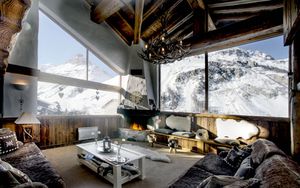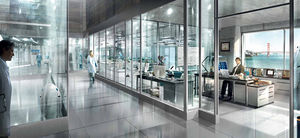Zatergast
History
Creation & Founding
Zatergast was developed and created in 1862 tucked deep within the mountains of Sayaffallah approximately 900 kilometers from the capital originally as a secretive laboratory for genetic research into unraveling and understanding the codex of dioxyribosenucleic acid and working to ensure that discoveries remained trade secret of the nation rather than dissiminated among a wider audience. By locating the complex in a mountain range and making it entirely self-sufficient it would allow researchers and scientists to work for years on end without ever needing to leave the complex.
The complex started construction in 1862 and saw its completion in the following December a week before the first snowstorms hit the valley in which the complex is nestled. Families of the researchers and scientists began moving into the complex in February as the last of the family housing complexes were complete and the facility was formally shut off from the rest of the country. The Zatergast complex when complete featured an elementary school, an academy for grades 9-12 and a university with professors teaching in over 62 different disciplines. In addition to this the complex was built with a large community pool and sauna system utilizing naturally occuring geothermal vents throughout the mountainside to provide heating not just for the pools at each home but also for the internal heating of all buildings in the complex.
Zatergast really however was the brainchild of Leopold Ziegeiter a preimminent researcher and scientist in the area of genetics who yearned for a place that could become a community of those wishing to eradicate disease, condition and disorders from Sayaffallah altogether through modifications of the genetic code. This research of his would become known as Designed Genetic Coding or DGC and to this day Zatergast remains a premier facility for genetic research and design with families still living in the complex.
Newcomers
1875-1902 saw the influx of over 6550 newcomers parents and children to a new series of buildings perched on the side of the mountain overlooking the main Zatergast complex. These newcomers were welcomed into the community and were given places in the schools and made to feel a part of the Zatergast community while they participated in the Fetal Stage trials that later led to the groundbreaking Fetal Stage Discovery that changed the game in the way that the field of epidemiology viewed disease, disorder and condition within Sayaffallah. As a result of the influx of newcomers additional lodgings had to be built on the side of the mountain and the school facilities were expanded to accommodate the large amount of newcomers at Zatergast. From 1903-23 a new group of families and children arrived to replace the outgoing group in Zatergast, this new group continued the invaluable research of genetic studies and continued to provide new insights into the way the human genome works.
Current Use
The Complex Today
Zatergast has an annual staff of 10,000 that work in the research laboratories on 12 year contracts after which are either rotated out based upon performance evaluations or the aspirations of the individual researchers and scientists in question. In addition to this individuals are only selected to come to Zatergast that have no more than a maximum of 4 dependents including their spouse due to the limited space within the mountain valley and the assigned housing complexes. Presently the housing on the outer mountain walls of Zatergast is divided among support staff for the Zatergast complex with only 50% being used for research participants as the sample size has decreased dramatically in recent years.
The complex has been renovated and redesigned as recently as 2007 with luxury in mind for the residents and privacy heightened to protect community relations specifically the ability of the community to work together efficiently without side problems rising up. Zatergast is also now linked by a series of underground tunnels from the housing complex office, which in turn has combination sealed tunnels to each individual home, to the laboratory system within the mountain valley itself. These tunnels allow for quick and efficient access to work environments even in the most brutal of temperature climates outside allowing researchers the ability to conduct their work in peace and quiet with minimal interference.
Researchers also now enjoy weekend trips out of the complex with a heliport transporting researchers to a nearby town where they can relax away from the compound. Security remains tight at the complex with only authorized personnel and their families allowed in and required to wear a lanyard with biometric fingerprint and barcode on a photo ID badge. All visitors are required to have a guide with them at all times and are restricted to a pre-approved visitor tour route with unlimited access to the museum at the complex entrance. As a result no visitors to the complex from the general public other than pre-approved relatives of those living in the complex are allowed to stay overnight within the complex for security purposes.
Research Facilities
The research facilities are some of the most state of the art facilities in Sayaffallah with the focus of research having moved to a dual focus of both medical research as well as commercial application research within genetics specifically designer genetics program allowing for the amplification of positive traits in the neo-natal and fetal stage of development the research facilities incorporate both. The hospital has the ability to handle 600 patients at any given time in various stages of recovery and assistance with top of the line life support systems to aid a dedicated team of researchers, scientists and physicians in providing the best patient care possible.
In addition to this there is office and laboratory space for every individual working in the expansive Zatergast system with areas for conferences, meetings and telecommunication as well as the handling of precise genetic based experimentation specifically in a cellular and nano-celluar level with advanced microscopic and analytic systems and reserve computing servers to handle the influx of data and to tightly control what data is allowed out of the complex. In addition to this there are facilities allowing for the study of other subject areas now outside of genetics exclusively but still pertaining to public health and the study of epidemiology with laboratories dedicated to the study of traumatic injuries after the development phase of human growth and laboratories dedicated to the study of synthetic applications for human development such as synthetic skin that could be applied to burn victims that would both meld to existing skin unnoticeably but also create a rapid growth of cells in the follicular level thickening and strengthening both newly developed skin and existing skin creating a much healthier skin than existed before.
Ziegeiter Museum Complex
The Ziegeiter Museum Complex is dedicated in the memory of Leopold Ziegeiter and is the home of the original laboratory that existed when the complex first opened in 1862 and is still assembled exactly the same way it was when in use by Leopold Ziegeiter during his time at Zatergast. In addition to memorializing and commemorating the life of Ziegeiter the complex museum showcases past and current research and has a large auditorium space where conferences are regularly held celebrating advances and work in genetic and medical treatment breakthrough studies. The auditorium is significantly large and has room for all 10,000 employees of the Zatergast in addition to over 5,000 guests.
The museum itself is situated at the helipad and formal entrance to the complex and includes a VIP reception area attached via a secure access corridor directly adjacent to the museum. The museum is open to the general public and although it includes emergency accommodations for 600 it is not open to the public for overnight stays except in emergencies in which the helicopter cannot return due to weather or dangerous conditions. Typically these accommodations serve as a place for extended family of those living Zatergast to stay as each individual home complex does not have room beyond the family members living in them. The museum has a rotating exhibit list with only one exhibit hall containing a permanent exhibition on the life of Leopold Ziegeiter himself.
Ziegeiter is buried in the museum complex in a large mausoleum directly outside the main auditorium hall. The mausoleum is accessibly by elevator and also by the large marble staircase descending 6 floors into the earth to a large domed room designed to look as if it was carved out of glacial ice. The mausoleum has the final words of Ziegeiter and has a memorial chapel tucked off to the side paid for by the living relatives of Ziegeiter.



